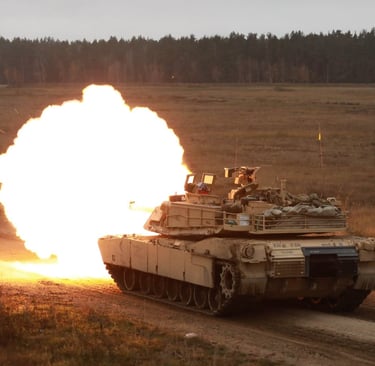The M1 Abrams: The Backbone of American Armor
Few machines symbolize modern military power like the M1 Abrams, the main battle tank (MBT) of the United States Army and Marine Corps. Known for its unmatched firepower, cutting-edge technology, and near-invulnerable armor, the Abrams has been the dominant force on the battlefield for over four decades. Designed to deliver decisive firepower while withstanding enemy attacks, the M1 Abrams remains the backbone of American armored warfare.


The Birth of a Legend
The M1 Abrams was developed in the 1970s as a response to the increasing threat posed by Soviet tank advancements during the Cold War. The U.S. Army needed a tank that could outgun, outrun, and outlast anything on the battlefield. After years of development, the M1 Abrams entered service in 1980, named after General Creighton Abrams, a distinguished tank commander from World War II and Vietnam.
Since then, the Abrams has undergone several upgrades to enhance its armor, firepower, and digital capabilities, ensuring it remains at the cutting edge of modern warfare.
Firepower: A Battlefield Game-Changer
At the heart of the M1 Abrams’ dominance is its 120mm M256 smoothbore cannon, which is capable of firing a variety of munitions, including:
Armor-Piercing Fin-Stabilized Discarding Sabot (APFSDS) – Designed to punch through enemy armor with high-velocity kinetic energy.
High-Explosive Anti-Tank (HEAT) Rounds – Effective against fortified positions and enemy vehicles.
Canister Rounds – Essentially a massive shotgun blast for engaging enemy infantry at close range.
With an advanced fire control system, the Abrams can engage moving targets at long distances with pinpoint accuracy—even while moving at high speeds. The tank's thermal imaging system allows it to fight effectively at night or in poor visibility conditions, giving U.S. forces a critical advantage in combat.
Armor: Nearly Indestructible
The M1 Abrams is one of the most heavily armored tanks in the world, utilizing Chobham composite armor, which combines depleted uranium, ceramics, and steel to provide unmatched protection. This armor makes it extremely resistant to enemy fire, including armor-piercing shells and rocket-propelled grenades (RPGs).
The tank also features explosive reactive armor (ERA) and active protection systems (APS) in some variants, further increasing its survivability against modern anti-tank weapons.
Speed and Mobility: Not Just a Heavyweight
Despite weighing nearly 70 tons, the M1 Abrams is surprisingly agile. Powered by a 1,500-horsepower gas turbine engine, the tank can reach speeds of up to 42 mph (67 km/h) on roads and 30 mph (48 km/h) off-road.
Its advanced suspension system allows it to traverse rough terrain with ease, making it highly effective in both urban and open-field combat. Unlike many other tanks, the Abrams was designed with mobility in mind, ensuring it can rapidly reposition and outmaneuver enemy forces.
Battle-Tested in Combat
The M1 Abrams has seen extensive combat since its introduction, proving its dominance in multiple conflicts:
Operation Desert Storm (1991) – The Abrams destroyed hundreds of Iraqi tanks, often at ranges where the enemy couldn't even return fire. The combination of superior firepower, armor, and optics made it an overwhelming force on the battlefield.
Iraq War (2003-2011) – The Abrams played a key role in the invasion of Iraq, supporting ground forces in urban combat and providing armored superiority against insurgent threats.
Afghanistan Conflict – Although primarily designed for conventional warfare, the Abrams was used in Afghanistan to support counterinsurgency operations, offering unmatched protection for ground troops.
In every engagement, the M1 Abrams has proven its reputation as one of the most lethal and survivable tanks ever built.
Upgrades and the Future of the Abrams
Despite being in service for over 40 years, the M1 Abrams is continuously modernized to maintain its battlefield supremacy. Some of the most notable upgrades include:
M1A2 SEP v3 – The latest variant features improved optics, communications, and defensive systems, making it the most advanced Abrams yet.
Active Protection Systems (APS) – Systems like Trophy APS intercept incoming anti-tank missiles before they reach the tank.
AI-Assisted Targeting – Future versions of the Abrams are expected to incorporate autonomous targeting and drone integration for even greater battlefield awareness.
While discussions continue about developing a next-generation main battle tank, the Abrams is expected to remain in service for decades, ensuring it continues to dominate the modern battlefield.
Conclusion
The M1 Abrams is more than just a tank—it’s a battlefield legend. Combining unrivaled firepower, cutting-edge technology, and near-invulnerable armor, it has become the gold standard of modern armored warfare. From the deserts of Iraq to the plains of Eastern Europe, the Abrams has proven time and time again that it is a force to be reckoned with.
As new threats emerge and technology evolves, the M1 Abrams will continue to adapt, ensuring that it remains the king of the battlefield for years to come.